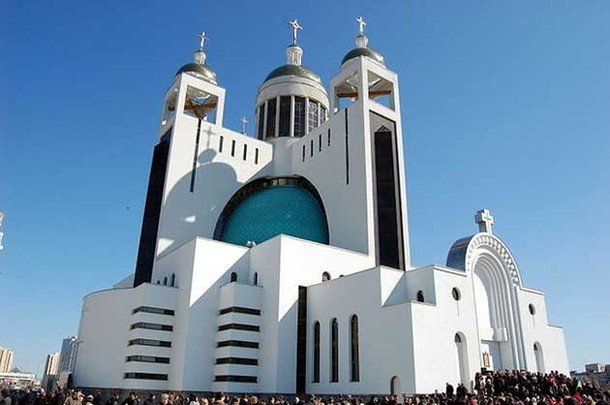Christianity took a firm root in the area now known as Ukraine in 989 when Vladimir, Prince of Kiev, embraced the faith and was baptized. Soon afterwards many missionaries, in particular Cyril and Methodius, arrived from the Byzantine Empire, having been sent by the Patriarch of Constantinople to preach the Gospel. They not only preached the Gospel but also created, using the Greek alphabet, the Old Slavonic language. The new alphabet became known as the Cyrillic alphabet and it transformed the various spoken dialects into a written language. Old Slavonic became the language of the Church (when I was ordained, some 48 years ago, that was the language of all of our services)
 When the Church of Rome and the Church of Constantinople severed ties with one another in the 11th century, the Church in the Mediaeval Slavic State of Rus gradually followed suit and finally gave up the bonds of unity with Rome. The Church in Rus, because it used the Byzantine ritual, became, in effect, an Orthodox Church. When the Ukrainian Orthodox bishops met at a council in Brest-Litovsk in 1595, seven bishops decided to re-establish communion with Rome. Guaranteed that their Byzantine tradition and Liturgy would be respected and recognized by Rome, they and many priests and lay faithful were re-united with the See of Rome. Others, however, remained in union with Constantinople which was, at that point in time, the head Church of Orthodoxy. The Ukrainian Greek-Catholic Church did not exist, as such, until the Union of Brest-Litovsk.
When the Church of Rome and the Church of Constantinople severed ties with one another in the 11th century, the Church in the Mediaeval Slavic State of Rus gradually followed suit and finally gave up the bonds of unity with Rome. The Church in Rus, because it used the Byzantine ritual, became, in effect, an Orthodox Church. When the Ukrainian Orthodox bishops met at a council in Brest-Litovsk in 1595, seven bishops decided to re-establish communion with Rome. Guaranteed that their Byzantine tradition and Liturgy would be respected and recognized by Rome, they and many priests and lay faithful were re-united with the See of Rome. Others, however, remained in union with Constantinople which was, at that point in time, the head Church of Orthodoxy. The Ukrainian Greek-Catholic Church did not exist, as such, until the Union of Brest-Litovsk.
In the 19th century many Ukrainian Catholics began to emigrate to North America, bringing their pastors, traditions and liturgical traditions to Canada and the United States. Under Communist rule, Greek-Catholics were persecuted. Many were imprisoned and murdered. In 1945 all the Ukrainian Greek-Catholic bishops were arrested or killed.
While our Ukrainian Greek-Catholic Church is in union with Rome, we are not considered Roman Catholics since we use the Byzantine ritual and embrace Eastern Christian theology. We have a different calendar of saints, with the exception of the major Christian holy days; we use the Byzantine lectionary, that is the sequence of readings, during the year; and have our own Eastern Canon Law as well as those particular laws called Statutes (these deal with the orderly direction of the apostolic work of our eparchies and parishes). All the Ukrainian Greek-Catholic Churches in the United States have promulgated the same Statutes.
